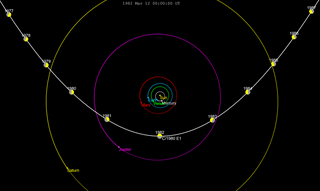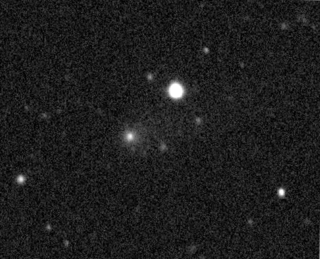Related Research Articles

Comet 4P/Faye is a periodic Jupiter-family comet discovered in November 1843 by Hervé Faye at the Royal Observatory in Paris. Its most recent perihelia were on November 15, 2006; May 29, 2014; and September 8, 2021.
39P/Oterma is a currently inactive periodic comet with an orbital period of nearly 20 years that stays outside the orbit of Jupiter. The nucleus has a diameter around 4–5 km. It was last observed in August 2021 and came to perihelion in July 2023 while 1.2 AU from Jupiter. It will finish the modest approach to Jupiter in January 2025 and will next come to perihelion in July 2042 at distance of 5.9 AU from the Sun. Opposition has occurred on 11 November 2023.

60P/Tsuchinshan, also known as Tsuchinshan 2, is a periodic comet in the Solar System with an orbital period of 6.79 years. Tsuchinshan is the Wade-Giles transliteration corresponding to the pinyin Zĭjīn Shān, which is Mandarin Chinese for "Purple Mountain".

77P/Longmore is a periodic comet in the Solar System, with a period of 6.8 years.

78P/Gehrels, also known as Gehrels 2, is a Jupiter-family periodic comet in the Solar System with a current orbital period of 7.22 years.

7P/Pons–Winnecke is a periodic Jupiter-family comet with a six-year orbit. Early calculations for the 1921 apparition suggested that the orbit of the comet might collide with Earth in June, but observations on 10 April ruled out an impact. It made a very close approach to Earth in June 1927. The outward migration of perihelion created impressive meteor showers in 1916, 1921 and 1927.

13P/Olbers is a periodic comet with an orbital period of 69 years. It fits the classical definition of a Halley-type comet with. The comet had last been seen in 1956 and the next perihelion is on 30 June 2024.
14P/Wolf is a periodic comet in the Solar System.
Comet 177P/Barnard, also known as Barnard 2, is a periodic comet with an orbital period of 122 years. It fits the classical definition of a Halley-type comet with. It orbits near the ecliptic plane and has aphelion near the Kuiper cliff at 48 AU (7.2 billion km).

Comet 96P/Machholz or 96P/Machholz 1 is a short-period sungrazing comet discovered on May 12, 1986, by amateur astronomer Donald Machholz on Loma Prieta peak, in central California using 130 millimetres (5.1 in) binoculars. On June 6, 1986, 96P/Machholz passed 0.404 AU from the Earth. 96P/Machholz last came to perihelion on January 31, 2023. The comet has an estimated diameter of around 6.4 km (4.0 mi).

C/1980 E1 is a non-periodic comet discovered by Edward L. G. Bowell on 11 February 1980 and which came closest to the Sun (perihelion) in March 1982. It is leaving the Solar System on a hyperbolic trajectory due to a close approach to Jupiter. In the 43 years since its discovery only two objects with higher eccentricities have been identified, 1I/ʻOumuamua (1.2) and 2I/Borisov (3.35).
C/2001 OG108 (LONEOS) is a Halley-type comet with an orbital period of 48.51 years. It was discovered on 28 July 2001 by the LONEOS telescope at Lowell Observatory. Of the short-period comets with known diameters and perihelion inside the orbit of Earth, C/2001 OG108 is the second largest after Comet Swift–Tuttle.

Comet Lovejoy, formally designated C/2011 W3 (Lovejoy), is a long-period comet and Kreutz sungrazer. It was discovered in November 2011 by Australian amateur astronomer Terry Lovejoy. The comet's perihelion took it through the Sun's corona on 16 December 2011, after which it emerged intact, though greatly impacted by the event.

44P/Reinmuth or Reinmuth 2 is a Jupiter-family comet that is greatly perturbed by the gas giant Jupiter. The diameter of this comet is estimated at 3.22 km and its absolute magnitude at 11.

40P/Väisälä is a periodic comet that was discovered on February 8, 1939. Its orbit was determined on April 26, 1939. In 1994, the diameter of its nucleus was found to be 4.2 km, similar in size to that of Comet Encke.

61P/Shajn–Schaldach is a periodic comet in the Solar System with a current orbital period of 7.49 years.

70P/Kojima is a periodic comet in the Solar System with a current orbital period of 7.05 years.
83D/Russell is a periodic lost comet in the Solar System with an orbital period of about 7.5 years. On the post-1988 orbit the comet probably does not get brighter than about apparent magnitude 21. The comet might come to perihelion in late May 2021, but the uncertainty in the comet's position is a few million km.
86P/Wild is a periodic comet in the Solar System with a current orbital period of 6.84 years.
273P/Pons–Gambart, also called Comet Pons-Gambart, is a short-period comet in a retrograde orbit first discovered on June 21, 1827 by Jean-Louis Pons and Jean-Félix Adolphe Gambart. It has a 186 year orbit and will next come to perihelion around August 2191. It fits the classical definition of a Halley-type comet with. It was lost and was not recovered until November 7, 2012, when amateur astronomer Rob Matson discovered a comet, and it was identified that the pre-recovery short-arc orbital calculations for Pons-Gambart were completely wrong because the comet only had a 1-month observation arc with poor data. It was last observed in April 2014 when it was 5.8 AU (870 million km) from the Sun.
References
- ↑ "89P/Russell 2" . Retrieved 15 April 2015.
- ↑ "89P/Russell Orbit". Minor Planet Center . Retrieved 2017-04-07.
- ↑ "86P/Russell 2". Gary Kronk. Retrieved 15 April 2015.

